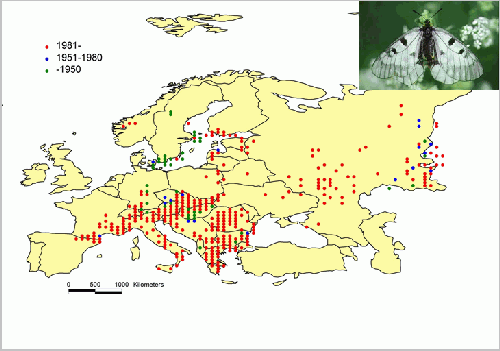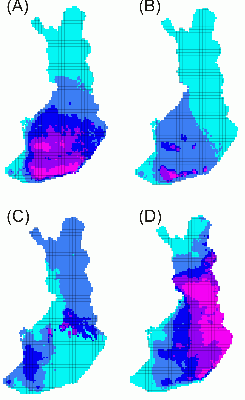Based on the empirical knowledge of the species ecology, and literature sources on butterfly ecology in Finland and Europe, 64 grassland-dwelling butterfly species were initially for the study. Next, a selection of 11 climate scenarios was outlined to cover the full range of the future projected changes in temperature and precipitation in Finland (mild, intermediate and severe changes) to investigate if the projected distributions of the butterfly species would diverge under different climate scenarios. In addition, two different sets of potential climate predictors for butterfly species were selected to study how much the choice of climate predictor variables affects the projections of climatically optimal areas. For all the studied butterfly species, bioclimatic envelope models were developed (calibrated) using data on their distribution in the whole Europe (data received via research collaboration from UFZ, Germany) within a 10 minutes x 10 minutes grid system which were related to the data on observed climate in Europe averaged over the period of 1971-2000 at the same resolution (Fig. 4).

Fig. 4. Observed distribution of one of the studied butterfly species, the Clouded apollo (Parnassius nemosyne), in Europe.
|
The bioclimatic envelope models were developed using the BIOMOD user interface, as implemented in the R statistical package, which enables building BEMs with several different modelling methods. In this six modelling methods were employed: Artificial Neural Networks (ANN), Generalized Additive Models (GAM), Generalized Linear Models (GLM), Generalized Boosting Methods (GBM), Mixture Discriminant Analysis (MDA) and Multiple Adaptive Regression Splines (MARS). Thus six different modelling methods times two different sets of climate predictor variables were used, and 12 different BEMs were calibrated for each of the study species. Next, the calibrated models were fitted to climate data from the 11 different scenarios averaged over the time slice of 2051-2080 for Finland. Overall, these procedures resulted in 132 individual BEMs and their projections for the future suitable areas in Finland developed for each study species, which showed occasionally notable "within-species" differences in the patterns of climatically most suitable areas (Fig. 5).

|
Fig. 5. Predicted climatic suitability for the Clouded Apollo (Parnassius nemosyne) in Finland for the time slice of 2051-2080 (pink=highest, light blue=lowest). (A) Climate scenario = CSIRO-MK3.0, modelling method = GAM; (B) CSIRO-MK3.0 and GBM; (C) CSIRO-MK3.0 and ANN; (D) Climate scenario = MIROC3 _2_medres and GAM.
|
In assessing the model uncertainty, the model performance we first evaluated and controlled for to exclude species and BEMs with weak or modest accuracy in the cross-validation tests; in this evaluation AUC and TSS statistics from BIOMOD were used as the species and model exclusion criteria. the model outputs showed that for a number of species the cross-validation accuracy of the BEMs was rather modest, suggesting that projecting future trends with such models may give rise to unrealistic, and at worst, incorrect forecasts; projections from such models need thus to be used only with much caution or excluded out-right. In the present results 10-15 butterfly species fell into this category.
The next phase of the process included the identification of areas forecasted as climatically most suitable by several methods, several scenarios and the two climate variable sets for each species (i.e. overlapping areas in the 132 single models which represent the most likely important areas under future climate). These areas of overlapping projected climatic suitability provided basis for the identification of "future hotspots" for grassland butterflies, i.e. areas where climatically important areas overlap for several species.
In the final part of the modelling process an approximate "optimal target" level for the amount of grassland habitat needed to support viable grassland butterfly species populations was determined. This will be done based on the GIS database for the cover of three types of grassland habitats resolution of 25 m x 25 m in Finland: (i) grasslands managed with funding from the agri-environmental scheme, (ii) grasslands that were identified as valuable for agro-biodiversity in the earlier national survey, but which currently do not have an agri-environmental contract, and (iii) common grasslands which usually are of low or moderate value for agro-biodiversity. Using these spatial grassland habitat data and the data from ca. 170 butterfly monitoring transects - particularly the most representative transects - a rough optimal target level was determined, suggesting that nearly 3% of the landscape should be covered by grassland habitats to support viable grassland butterfly populations. This information was then used in assessing how well the future climatically important areas reach this target level, and where there most notable gaps in terms of habitat availability exist. This was done both for the projected hotpots of climatic suitability and the hypothetical ecological corridor outlined for the three example species.

